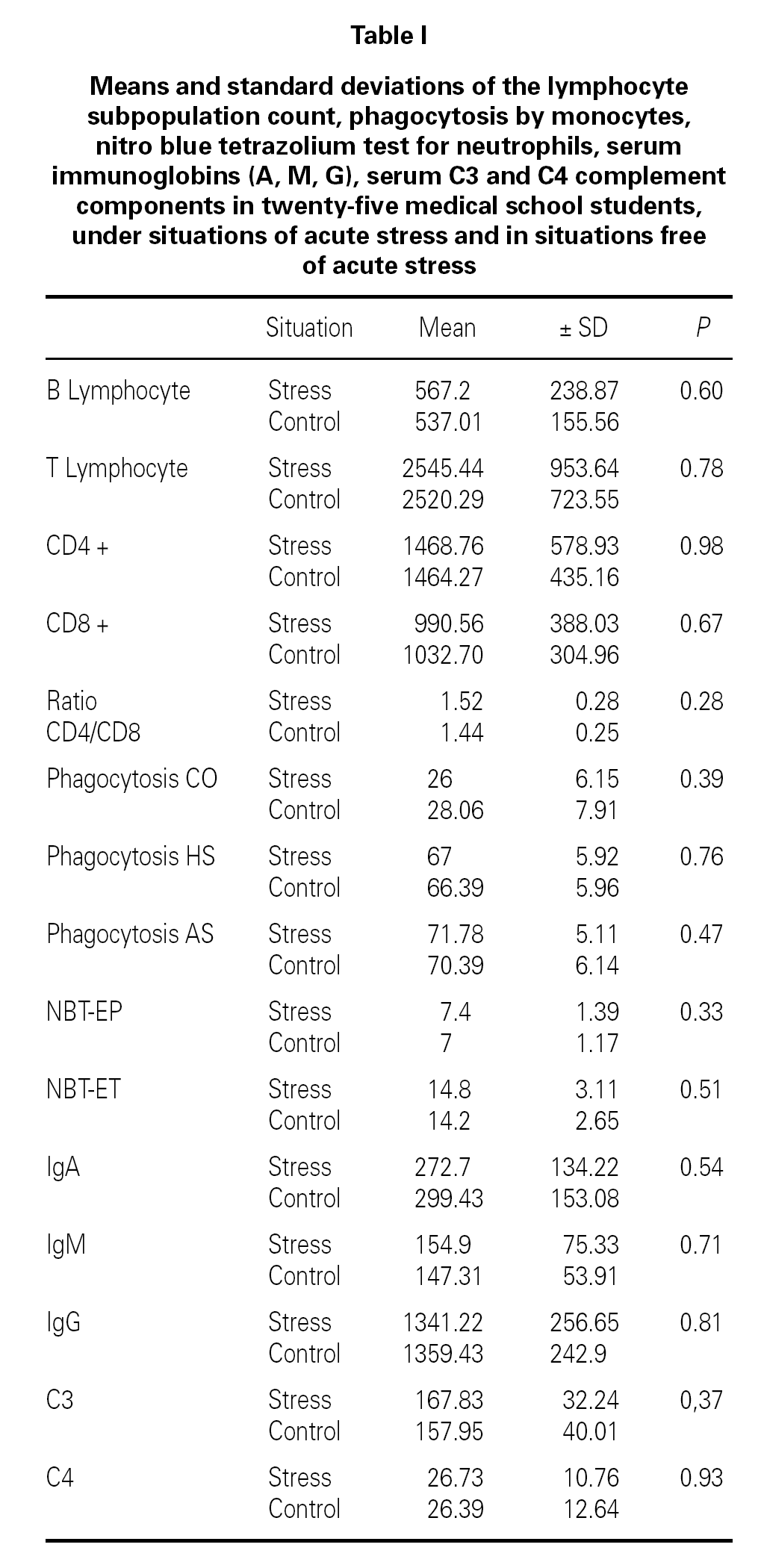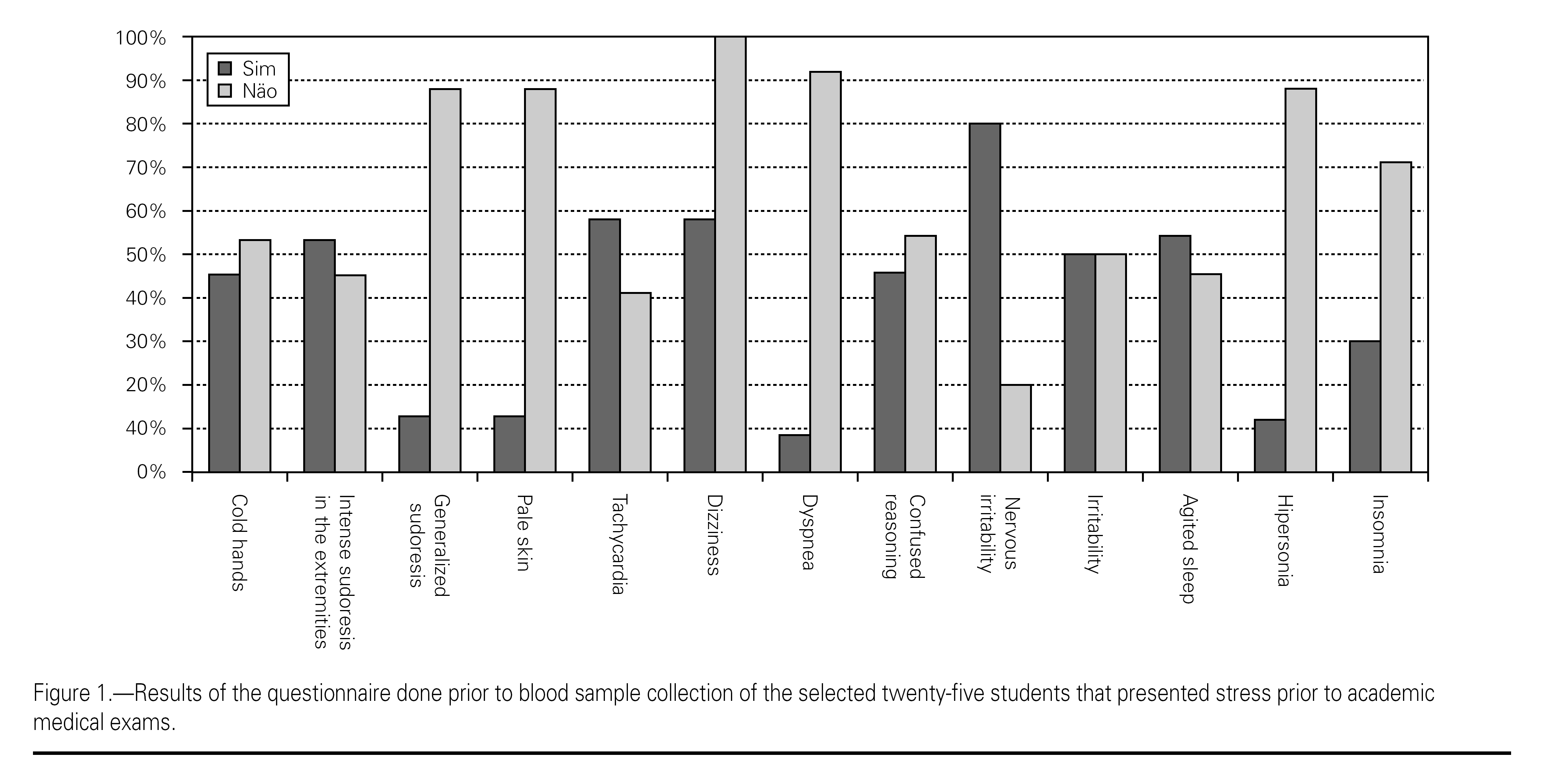INTRODUCTION
The concept that stress can affect one's health is not new, having been reported for centuries, especially in cases of the chronic form. However, only recently have researchers been able to carry out a more detailed study of this fact, with suggested interrelation between the immune, nervous, and endocrine systems 1-3. Thus, situations that cause an increase in mental stress, especially if chronic, provoke nervous and hormonal alterations that culminate with the depletion of the immune system 1-4.
In the literature, there are few studies concerning immunocompetence and acute stress, and those that do exist are mainly in experimental models. In rats, a reduction in the proliferation of thymus-dependent lymphocytes (T) in the lymph nodes and spleen was observed after immunization of the models when these were immediately subjected to repetitive electric shocks 5,6. In yet another study, with rats submitted to the same process, an accentuated depression in the activity of peripheral natural killer (NK) cells was observed 7. Swine models with aggressive behavior presented a depression in the cellular and humoral response 8 and those that were submitted to stress for 72 hours presented depression in the lymphocytic and mitogenic response 9. Rats submitted to stress provoked by exposure to low temperatures presented a reduction in corticosteroids, thyroidal hormones, and bursa-equivalent (B) 10 lymphocyte levels. Researchers have proposed the possible existence of an immune-endocrine-nervous axis in mice 11 and in birds 12.
Research about acute stress and immune response in humans has been done mainly in individuals with specific diseases 7. It has been demonstrated that patients who underwent post-traumatic stress present a reduction in the function of peripheral monocytes 13. Patients submitted to abdominal surgeries for cholecystectomy when compared to other patients submitted to the same surgery, though through laparoscopy, presented reduction in the tumor necrosis factor (TNF) and in the release of superoxide anions by monocytes 14. Patients with coronary diseases, when submitted to angioplasty after acute stress presented activation of the hypothalamus-hypophysis-adrenal axis, accompanied by a reduction in serum interleukins 1 and 2 (IL 1 and IL2) 15.
After the observation that some students presented emotional alterations during exams, coinciding with a sequence of a greater incidence of infections, like the common cold, flu, tonsillitis, and pharingitis, we proposed to investigate the immune response of these students, after the research protocol was approved by the Institution's Ethics Committee and informed consent was obtained from each student.
PURPOSE
The aim of this study is to analyze the levels of T and B lymphocytes, CD4 and CD8 positive cells, phagocytosis by monocytes, assess the serum levels of IgG, IgM, IgA and of the C3 and C4 complement components, and use the nitro blue tetrazolium test for neutrophils, in students presenting signs and symptoms characteristic of acute stress, and comparing the exam results with the same values obtained from the same individuals in conditions free of acute stress.
METHODS
Twenty-five students were chosen with signs and symptoms of cold hands, intense sudoresis in the extremities, generalized sudoresis, pale skin, tachycardia, confused reasoning, nervous irritability, diarrhea, and sleep disorders in the hours prior to the exam (agitated sleep, insomnia). All of the blood samples were obtained in the morning period. The exams were repeated for the same students in situations free of acute stress. The results of the two samples collected from each individual were compared.
Evaluation of lymphocytes was done by separation of these cells using the Ficoll-Hypaque gradient and posterior incubation with monoclonal antibodies CD19 (B lymphocytes), CD3 (T lymphocytes), CD4 (T auxiliary) and CD8 (T cytotoxic). All of the tests were done in duplicate form.
In the study of phagocytosis by mononucleated cells, the following procedure was used: separation of 5x10 6 cells and incubation in three tests tubes, one containing 10 8 particles of Zymosan (Zy) as the control, one containing Zy and homologous serum (HS), and one with Zy and autologous serum (SA). Subsequently, the number of cells that phagocytized three or more particles of Zy in a fixed number of 200 monocytes was determined. All tests were done in duplicate form.
For the evaluation of neutrophils, the spontaneous and stimulated nitro blue tetrazolium test was done using bacterial lipopolysaccharides, obtained from heparanized blood and using 0.1 % buffered NBT. All tests were done in duplicate form.
The immunoglobulin and complement component values were obtained using the Mancini method, based on the diameter of the precipitation halo, which was correlated with the standardized values for each batch used of the radial immunodiffusion plaque, with readings performed after a 48 hour period for IgG and 72 hours for IgM and IgA.
Statistical analysis of this study was done using the Student-t test. For this, the Microsoft Excel 2000 software from the Microsoft Corporation® was used.
RESULTS
Of the twenty-five students were chosen, since the reference value of 60 % or more for the presence of signs and symptoms proposed in the questionnaire. The students were selected to participate in this study, 64 % were women and 34 % were men, and the mean age was of 20.8 (± 2.07) years. The obtained results are shown in figure 1 and in table I.
Figure 1.--Results of the questionnaire done prior to blood sample collection of the selected twenty-five students that presented stress prior to academic medical exams.
DISCUSSION
Signs and symptoms of cold hands, intense sudoresis in the extremities, generalized sudoresis, pale skin, tachycardia, confused reasoning, nervous irritability, diarrhea, sleep disorders in the hours prior to the exam (agitated sleep, insomnia) presented by the students in this study are considered classic of acute stress. Though other students reported stress in the mentioned situation, twenty-five students were chosen, since the reference value of 60 % or more was chosen for the presence of signs and symptoms proposed in the questionnaire, with the goal of obtaining more objective values of acute stress, though there is no need of division for this consideration. On the other hand, the applied questionnaire demonstrated the exacerbation of the sympathetic autonomous nervous system during this state of stress, having different combinations of the manifestations in all of the patients analyzed, proving that which was compiled by several studies in the 1980's 1-3.
During analysis of the laboratory exams used for lymphocyte subpopulation counting using the monoclonal antibodies CD19 (B lymphocytes), CD3 (T lymphocytes), CD4 (auxiliary lymphocytes), CD8 (cytotoxic T), we verified that these are considered reliable for the evaluation of lymphocyte populations 16,17. For laboratory complementation, phagocytosis by monocytes in three separate tests was done using living cells: the first aiming to analyze the viability of these cells, in other words, to determine if these remain alive during the experiment (CO), and the second and third aiming to analyze the functionality of the monocytes, with the second test containing homologous serum (HSM) in which zymosan that is activated by the complement system of a pool of normal human serum activates component C3b that joins to a specific receptor of these cells, allowing phagocytosis; the third test is done with serum of the patient (SA), which also acts on the complement allowing phagocytosis to occur. With the first test preserved and because there was no difference between the 2nd and 3rd test, we can put aside the question of the functionality of these cells as to the phagocytosis digestion phase 18-22. Nitro blue tetrazolium (NBT) demonstrates that neutrophils are liberating electrons because they are captured by the soluble NBT dye, reducing it to formazan. This particle has a dark blue color and deposits itself on the cytoplasm of the neutrophils, indicating that the digestion phase is preserved. The stimulated NBT was used to reinforce this test, due to the fact that the latex used can double or even triple the values obtained by the spontaneous test classically used for immunological investigation 21. Immunoglobulin and C3 and C4 complement component serum value assessment was done using simple radial immunodiffusion, according to the classic methods developed since Mancini.
We did not observe a statistically significant difference between the results of the samples collected during the period of acute stress and of the control obtained for each student. It is possible that the stress presented by some students facing exams for graduation, though many times associated to infectious processes, is not as intense as the stress induced in experimental models, in which immune alterations were observed 5-10. It is even probable that the acute stress presented by patients prior to surgeries may affect the immune response even more.
The literature presents few references to acute stress in humans free of specific diseases, and furthermore it is a controversial subject in respect to this.
A study was done with a 12 month follow-up in individuals submitted to intense acute stress in a laboratory environment, by means of a 2 hour long discussion, and demonstrated that some people exposed to acute stress develop infection in the superior aerial tract; a predictive correlation was observed between high levels of cortisol, reduction in NK and CD8 cells, an increase in the CD4/CD8 ratio for the subsequent development of these infections 23.
Recent studies with patient samples more similar to ours corroborate our results. In a study done in Chile in which 42 medical students were evaluated in stressful situations few minutes prior to final exams, the researchers did not observe alterations in the lymphocyte subpopulation count, in spite of elevated serum levels of cortisol and the reduction of these cells in relation to mitogens 4. Likewise, a study done with professors that maintain daily chronic stress because of the work entailed, and that were submitted to acute stress through the undertaking of resolving enigmas with incomplete solutions, in a restricted period of time, followed by the explanation of this to the researchers, it was observed that the biological variation of the organism is intimately related to individual characteristics, varying with the level of chronic basal stress and not to the level of acute stress 24. This can be correlated with results of our study when we observe the individual results, due to the fact that the students who participated in our study could have maintained an increased basal stress throughout their entire college education, presenting only non-significant immunologic alterations at the moment of acute stress.
We conclude that immunologic evaluation of medical school students, selected because they presented clinical signs and symptoms of acute stress preceding academic exams, did not demonstrate an alteration in the lymphocyte subpopulation count, of the phagocytotic response by monocytes, of the phagocytosis digestion phase by neutrophils, of the IgA, IgM, IgG, and C3 and C4 complement component serum levels during acute stress.
Correspondence:
Wilma Carvalho Neves Forte
Alameda Barros 399, Apto. 162 - Higienópolis
São Paulo São Paulo Brasil
CEP 01232-001
E-mail: wilmanevesforte@yahoo.com.br








